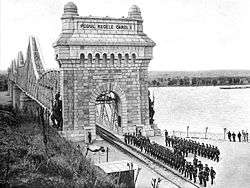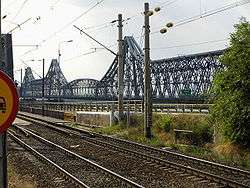Anghel Saligny Bridge
| The King Carol I Bridge | |
|---|---|
 | |
| Coordinates | 44°20′26″N 28°01′01″E / 44.340433°N 28.017017°ECoordinates: 44°20′26″N 28°01′01″E / 44.340433°N 28.017017°E |
| Carries | single-track electrified railway line |
| Crosses | Danube |
| Locale | Between Cernavodă and Feteşti |
| Characteristics | |
| Design | Anghel Saligny |
| Total length | 2,632 m (8,635 ft) |
| Longest span | 190 m (620 ft) |
| History | |
| Opened | 26 September 1895 |
The Anghel Saligny Bridge (formerly King Carol I Bridge) is a railroad truss bridge in Romania, across the Danube River, connecting the regions of Muntenia and Dobruja. The bridge is listed in the National Register of Historic Monuments.[1]
History
The bridge was built between 1890 and 1895 over the Danube, the Borcea branch of the Danube and the Balta Ialomiței island, and when it was completed, with a total length (with viaducts) of 4,087.95 m (13,411.9 ft), it became the longest bridge in Europe and the second longest in the world.[2] The bridge was designed by the Romanian engineer Anghel Saligny. The two cities on the banks of the river which was built were Feteşti on the left side and Cernavodă on the right side.
The crossing of Danube at Cernavodă was provided through a bridge with a central opening of 190 m (620 ft) (the largest in Continental Europe) and other four openings of 140 m (460 ft), beside to a viaduct with 15 openings of 60 m (200 ft) each. Another bridge, with three openings of 140 m (460 ft) and 11 openings of 50 m (160 ft), was designed and realized over the Borcea branch.[3] The two bridges have a length of 2,632 m (8,635 ft) of which 1,662 m (5,453 ft) over the Danube and 970 m (3,180 ft) over Borcea, and are 30 m (98 ft) above the water, allowing tall ships to pass under it. Between the two bridges there was a 1,455 m (4,774 ft) viaduct over the Balta Ialomiței island, with 34 openings of 42.8 m (140 ft) each.
The entire bridge was inaugurated on 26 September 1895, and as a test on the opening, a convoy of 15 whistling locomotives sped at 60 km/h, followed by a train reserved for 'guests', at 80 km/h.
In the 1960s, after large parts of the Balta Ialomiței island were reclaimed for agriculture, the original viaduct over it was replaced with an embankment.
Anghel Saligny Bridge complex has been exclusively used for almost a century, until 1987, when the new Cernavodă Bridge complex, built next to it, was inaugurated.[4]
Gallery
- The bridge during the early 20th century
 Bridge archway
Bridge archway A pillar
A pillar Anghel Saligny Bridge in 2006
Anghel Saligny Bridge in 2006
See also
References
- ↑ Podul Carol I cu statuia Dorobantul at constanta.djc.ro (in Romanian)
- ↑ Meltem Toksoz; Biray Kolluoğlu (25 August 2014). Cities of the Mediterranean: From the Ottomans to the Present Day. I.B.Tauris. pp. 172–. ISBN 978-0-85771-140-3.
- ↑ Danube bridges Archived October 7, 2010, at the Wayback Machine.
- ↑ Danube bridges Archived October 7, 2010, at the Wayback Machine.
External links
| Wikimedia Commons has media related to Anghel Saligny Bridge. |
- King Carol I Bridge at Structurae
- Bridge over the Borcea Branch at Structurae
Coordinates: 44°20′25.56″N 28°1′1.26″E / 44.3404333°N 28.0170167°E